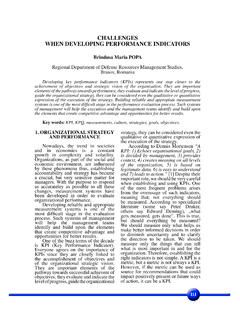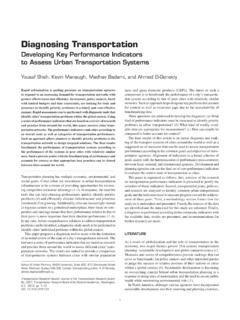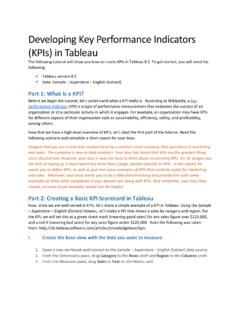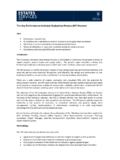Transcription of Measuring Impact and Developing Key Performance …
1 1 evaluation of Rochdale Families Project Measuring Impact and Developing Key Performance Indicators: a suggested framework for future evaluations John Flint November 2010 1. Introduction This report reflects on the use of techniques for Measuring the Impact and effectiveness of family support projects and the wider provision of support services to vulnerable families. It begins by setting out some of the challenges in Measuring the Impact and outcomes of specific initiatives. It then distinguishes between process evaluation , Measuring outputs and quantifying longer-term outcomes. The report concludes by identifying a set of qualitative and quantitative key Performance measures that may be utilised in the future assessment of the effectiveness and impacts of family support initiatives and services. 2. Challenges There are a number of inherent challenges facing the robust evaluation of family support projects and initiatives and identifying the specific and direct causal Impact of an initiative on outcomes for individuals, households, communities and agencies.
2 These challenges have been discussed at length in previous studies (see Dillon et al., 2001; Nixon et al. 2006; Nixon et al., 2008; Pawson et al. 2009; Gregg, 2010; Wright et al., 2010). There are four in particular that this report will focus upon: Attributing causality Capturing qualitative soft outcomes Assessing cost-benefits Resources 2 Attributing causality It is incredibly difficult to isolate and quantify the direct causal Impact of one specific support initiative on the outcomes for a family. This is for three key reasons. Firstly, as Figure 1 below identifies, a family support service is located within a very complex web of influences and interactions impacting upon a family. These include the underlying and multiple causal factors of vulnerability and problematic behaviour (many of which are multi-generational), the continuing influence of a range of actors and factors, including extended family members, peers and the wider neighbourhood environment (physical, social and cultural), and the range of agencies and organisations who may be interacting with the family.
3 It is also for this reason that control groups and/or randomised control trials (originally considered for this and other evaluations of family support projects) have not been utilised. Secondly, progression for a family is rarely linear- there are often periods of disengagement, remission and crisis which are often caused by factors external to the support being provided. Thirdly, the time dimension of interventions is complex: services are often addressing long-standing and deep rooted problems; crisis management, stabilising a situation and inculcating improved confidence, esteem and aspirations, enhancing parenting skills and family dynamics are the building blocks to successful outcomes, but many of these forms of progress are hidden and there may be a long time period between this progress and the achievement of more visible and measurable outcomes.
4 It can also take a considerable period of time for project workers to secure the engagement and trust of families and to undertake a robust assessment that accurately identifies the support needs of families. These steps are essential to the likely effectiveness of interventions, but this can be in conflict with Performance indicators based upon exiting a family within a particular time period or working with a target number of families. Finally, it is difficult to assess the longer term outcomes and the sustainability and therefore cost effectiveness of interventions as this involves the longitudinal tracking of families in the post- intervention period. 3 4 Capturing qualitative soft outcomes Family support projects and services, in order to be effective, are required to take a holistic, whole-family approach that addresses underlying problems and that develop multi-agency packages of intervention.
5 This means that projects and project workers undertake a range of roles, including engagement, assessment, the development of support plans, the provision of support and exit planning (see Figure 2). EngagementBuilding trustAssessmentDialogueHome visitsLiaison with agenciesDevelopment of support plan Provision of supportExit PlanningDirect support(See Figure 3)Referral to other servicesCAMHSD rugs/alcohol supportSpecialist educationYouth support servicesYouth groupsAdvocacy with other servicesEducationHousingCAMHSS ocial ServicesFigure 2: Project Worker Roles The diversity of these roles, combined with the scale of the problems facing families and the instability in their circumstances make any robust assessment of effectiveness complex. This also highlights the importance of recognising the value of the achievement of less visible and soft outcomes.
6 Figure 3 below provides a typology of outcomes that may be achieved by a family support project or service. The ultimate aim of family support projects and services is to achieve sustainable transformative change. However, projects and services may also achieve two other categories of outcomes that are both vital in their own right and form the building blocks upon which transformative change may be achieved. A project may, through effective crisis management, reduce the immediate risk of harm and escalation of risk and problematic behaviour. This is very difficult to measure (although see below). However, this can achieve a major cost-benefit to agencies (for example preventing enforcement action or the need for a child to be taken into care) as well as obvious benefits for the wellbeing of families. A project may also achieve incremental but significant outcomes through 5 stabilising a family and its circumstances.
7 However, none of these outcomes can easily be measured through Performance indicators. Even where interventions achieve transformative change, a set of soft outcomes, while crucially important and directly linked to the sustainability of progress, can only be captured qualitatively and relate to the domestic environment and individual wellbeing. These outcomes may be assessed through capturing the subjective perceptions of a range of actors, and it is recommended that this forms part of future evaluation processes (see below). But these outcomes cannot directly be related to inputs or cost-benefits. 6 Assessing cost-benefits In the current and future period of fiscal austerity (see the following resources section) the funding of projects and initiatives and delivery of services has to be based on the most efficient use of increasingly pressurised resources.
8 However, assessing the cost-benefits of family support projects and services faces a number of challenges. Previous evaluations have indicated that such projects are, ultimately, likely to be cost-effective (Dillane et al., 2001; Pawson et al., 2009). However, this general finding, based on sophisticated economic analysis, is subject to a number of complications. Firstly, it is often based on a counter-factual scenario on the basis of costs that may have accrued if support had not been provided ( a child needing to be taken into care, the issuing of an Anti-social Behaviour Order, eviction, needing to house a family presenting as homeless etc.). However, this cannot be based on a basic baseline/ change or 'before and after' evaluation . Secondly, the cost savings potentially resulting from an intervention will accrue over the lifetime of family members and may not necessarily be recouped within the budget, planning and evaluation periods which local authorities and others have to operate within.
9 Thirdly, the savings to public agencies will be uneven and agencies benefitting from the intervention may not necessarily be those contributing to the funding of a project or service (this is essentially a political issue). Finally, although previous evaluations of projects indicate their cost-effectiveness, it has not been possible to base this on the sustainability of positive outcomes through tracking service users over a longer time period (although see Nixon et al., 2008). These challenges need to be considered when Developing a framework for the future evaluation of family support initiatives and services. This is also linked to a more fundamental understanding, conceptualisation and rationale of what projects and services are trying, and actually able, to achieve. Although, correctly and understandably, funding for such projects has emphasised sustainable transformation and Measuring verifiable outcomes, these projects can be effective and achieve very significant outcomes that cannot be easily measured, may not result in transformation (as defined in targets or Performance indicators) and are not amenable to economic cost-benefit analyses.
10 Resources In Developing this suggested framework for evaluation , we are acutely aware of the period of fiscal austerity facing local authorities and their partners. This will, most fundamentally, have a direct Impact upon the provision of services and initiatives to vulnerable families. However a secondary consequence will be limited resources to either fund comprehensive and robust external evaluations or to undertake large -scale evaluation activities in-house. This raises challenges as even well funded evaluations undertaken by experienced research teams (such as the study of Rochdale Families Project) face barriers in accessing data and engaging with the necessary range of stakeholders and actors, including service users. Whilst making the point that robust evaluations should produce the most comprehensive and sophisticated assessments of the impacts and effectiveness of initiatives and services, we have deliberately developed a framework of evaluation activities that may realistically be undertaken 7 whilst minimising the time required by those undertaking and contributing to these research activities.









